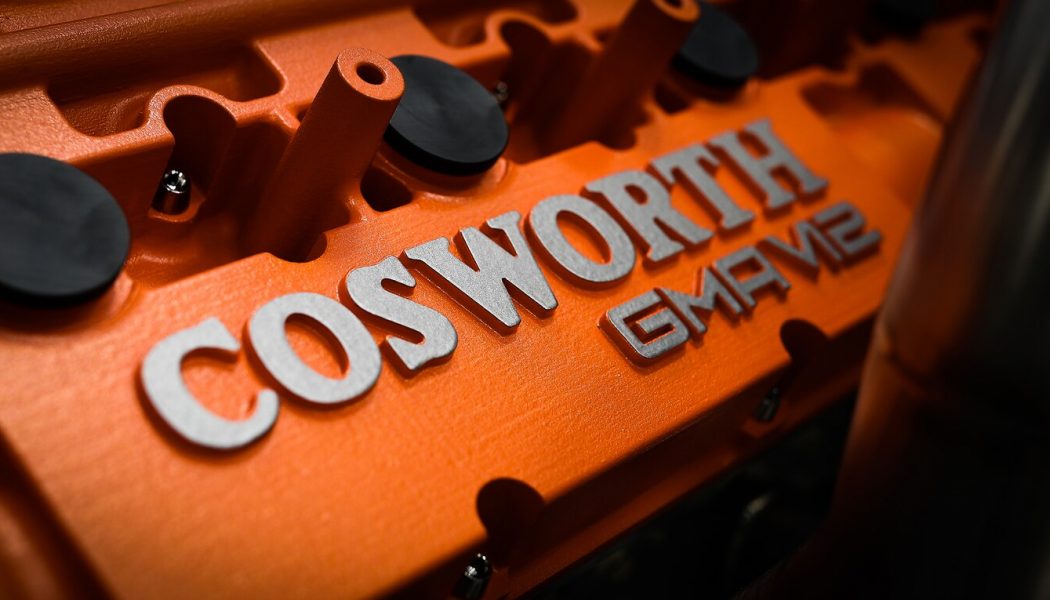Gordon Murray thinks the Cosworth GMA V12 will be one of the most iconic engines of all time. The ultra-light, ultra-compact, naturally aspirated V-12, developed by Britain’s Cosworth Engineering to Murray’s precise specification, will power a pure, driver-focused, lightweight three-passenger hypercar called the T.50, a car designed to be the successor to his ground-breaking McLaren F1 that rocked the 1990s.
The Gordon Murray Automotive (GMA) T.50 will make its public debut on August 4. But GMA has released a wealth of detail on the extraordinary engine that will power it. We brushed the surface of the engine’s magic recently, but consider this the deep dive.
Murray wanted a 12-cylinder engine for the T.50 from the outset. “To be truly remarkable, an engine needs to have the right character,” he explains. “It must be highly responsive, have an amazing sound and engaging torque delivery, be free-revving and it has to be naturally aspirated. For all those reasons, the engine in the T.50 was never going to be anything other than a V-12.”
A key element of the design brief was to keep the overall size of the engine as small as possible. Murray cites the 3.0-liter V-12 that powered the legendary Ferrari 250 GTO as one of the original inspirations for the Cosworth GMA. Other influences included the 3.5-liter Honda RA121E V-12 that powered Ayrton Senna and Gerhard Berger’s McLaren MP4/6 F1 racers in the early 1990s—the best of the F1 V-12s in terms of performance, balance and weight, Murray insists—and the BMW S70/2 V-12 that powered his McLaren F1 road car.
Designed from scratch and sharing no components with any other engine, the Cosworth GMA displaces 3.9-liters and has a 65-degree vee angle. The 29-pound steel crank sits very low in the block, just 3.4 inches from the bottom of the engine, 32 percent lower than the crank location of the F1’s BMW S70/2 V-12. The twelve connecting rods and 48 valves are titanium, as is the clutch housing for the six-speed manual Xtrac transmission. The camshafts and all ancillaries are gear driven—there are no belts. The whole engine weighs just 392 pounds, 143 pounds less than the F1’s BMW powerplant.
Producing 164 horsepower per liter, the Cosworth GMA has the highest specific output of any naturally aspirated road car ever built. The engine makes 654 horsepower at a screaming 11,500 rpm, and will rev to 12,100 rpm. Its peak torque of 344 lb-ft arrives at a dizzying 9,000 rpm, but 245 lb-ft is available from just 2,500 rpm to ensure tractability in everyday driving conditions. Vmax Mode, which trims the aerodynamics to low drag settings, unleashes a further 49 ponies from the car’s 48-volt integrated starter-generator to enable the T.50 to hit top speed.
Murray wanted the Cosworth GMA to be the most responsive road car engine ever and claims it can zing from idle to 12,100 rpm in just 0.3 seconds. He says it’s almost three times as responsive as the F1’s BMW V-12 and sets a benchmark that’s unlikely to be surpassed by a road car.
It’s not just the pursuit of light weight, compact dimensions, high revs and ultimate throttle response that made it inevitable the Cosworth GMA would be naturally aspirated. “You can never get a great sound from a turbocharged engine,” says Murray. The T.50’s cold-air ram induction intake sits immediately above the driver’s head and uses varying thicknesses of carbon fiber in the roof to act as a loudspeaker, amplifying engine sound in the cabin. Because the system relies on throttle angle and not engine speed, the T.50 will be quiet and refined on part throttle, the engine note growing louder as the driver pushes through half-throttle and beyond.
“The T.50 engine sound is going to be phenomenal,” enthuses Murray. “The intoxicating growl that drivers love is introduced as the throttle angle increases. The sound intensifies as the induction noise kicks in, then as you push towards the upper end of the rev range the V-12 will sing like nothing else on the road.”
Unlike the Aston Martin Valkyrie, whose 1,000-hp, 6.5-liter, naturally aspirated V-12 will be a fully structural member of the car, bolted directly to the carbon fiber tub like a Formula 1 car powerplant, the T.50’s engine will be a semi-structural unit. It will be isolated from the cabin via a complex arrangement of mounts to reduce noise, vibration and harshness, but will also support the rear suspension arms that attach directly to the transmission. The six-speed manual Xtrac transmission weighs just 177 pounds, its cast aluminium housing a mere 0.1 inches thick.
The McLaren F1’s astounding V-12 owed a lot to the engineering genius of BMW engine guru, Paul Rosche. The Cosworth GMA V-12 that will power its spiritual successor, the T.50, is Gordon Murray’s baby. “I started my career as an engine designer,” he says, so conceiving and specifying the 3.9-litre V-12 for the T.50 was such a joy. Having a blank sheet of paper and setting out to create the world’s best, highest-revving, most beautifully crafted, amazing sounding engine is something I’ve been waiting to do for years.”










